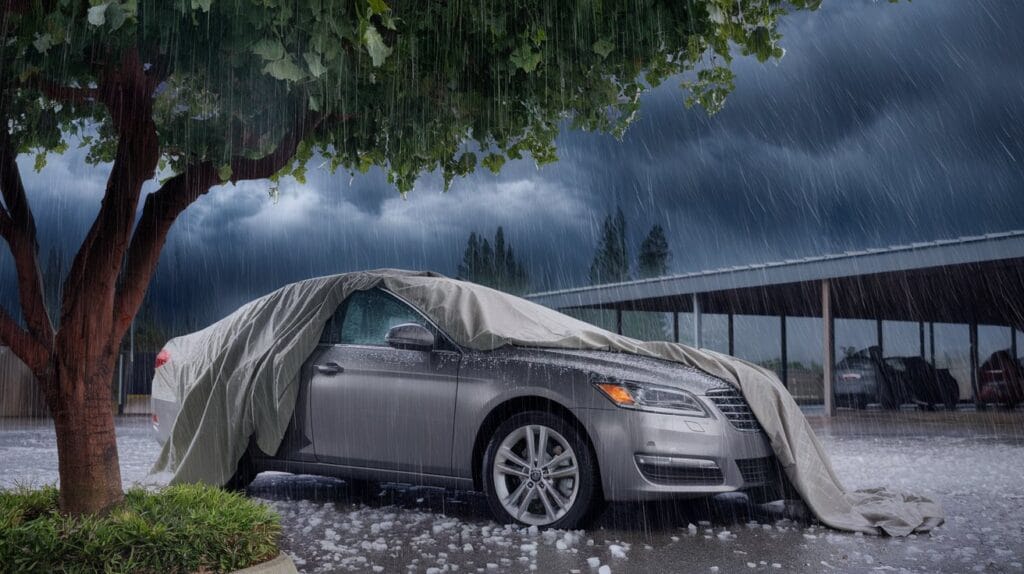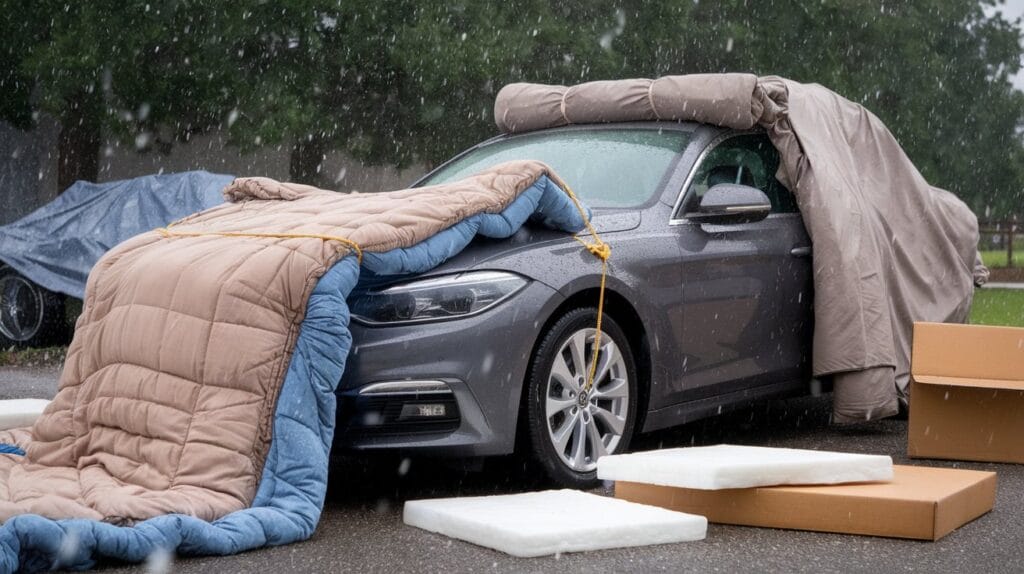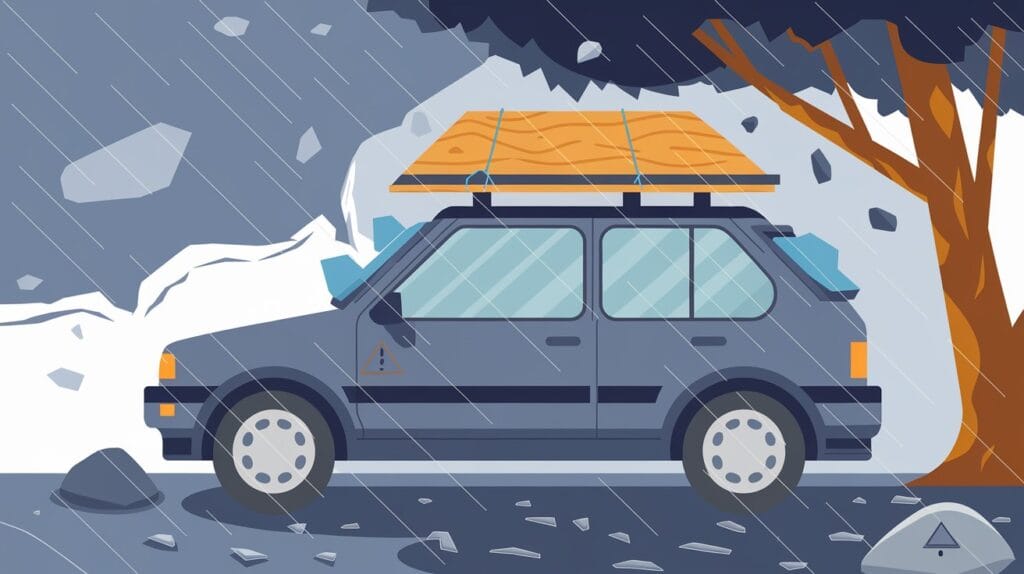Is your car ready to face the next unexpected hailstorm? Hail can strike without warning, turning your vehicle into an expensive repair project in minutes. For those without access to a garage, the challenge of keeping your car safe from hail damage can seem overwhelming. Thankfully, with a few innovative approaches and some practical solutions, you can minimize the risk and avoid hefty repair bills.
From car covers to air-cushioned shields and foam padding, there are effective ways to create a barrier between your car and the elements. Many hail-resistant covers can even be inflated right before a storm, giving your car a layer of protection from dents and cracks.
But even the best protection isn’t foolproof, so auto insurance with comprehensive coverage is also essential. Knowing your policy details—deductibles, limits, and how a claim might impact premiums—can ensure you’re financially covered for hail damage repairs. By combining preventive measures with solid insurance, you’ll be prepared to keep your car safe this hail season and beyond.
To protect your car from hail, take proactive steps like using hail-proof covers, blankets, or car mats. Make sure to monitor weather forecasts and park in sheltered areas when possible. Comprehensive auto insurance can also safeguard against costly repairs from hail damage, offering peace of mind when storms strike.
Understanding Hail Damage & Its Impact
Hail is a type of frozen precipitation that forms when strong updrafts in a thunderstorm lift raindrops into extremely cold areas of the atmosphere. As these hailstones fall, they can grow to large sizes, even as big as golf balls or baseballs. When they hit your car, the impact can cause serious damage to both the exterior and interior.
Dented roofs, shattered windows, or even totaled vehicles are possible consequences of a hailstorm. It’s important to take steps to protect your car from hail, as damage can mar a car’s appearance with dings, dents, and cosmetic blemishes.
Beyond cosmetic damage, hail can significantly affect your car’s value if you plan to sell or trade-in. Potential buyers and dealerships may hesitate to offer a desired price if the vehicle’s appearance is compromised.
The cost of repairing hail damage also varies based on severity; minor repairs may cost a few hundred dollars, while more severe repairs, like fixing cracked windows or fractures, can reach thousands of dollars. During peak hail season, repair shops are often inundated with vehicles needing attention, leading to longer wait times and higher costs due to the increased demand for repairs.
Also Read: Is Your Car Losing Gas While Off? Find Out Why!
Protecting Your Car’s Exterior in a Hail Storm

Protecting your car’s exterior from the wrath of an unpredictable hailstorm requires a solid game plan. Hailstorms can happen anytime during the hail season, so preparing in advance is essential. With the right defenses and tips in mind, you can armor your vehicle and keep it safe from icy pellets.
Check the Hail Forecast
Before going somewhere or relaxing at home, it’s wise to check weather forecasts. Although no forecast is one hundred percent accurate, being aware of possible hail storms gives you time to protect your car from unwanted damage.
Seek Shelter, Always
The golden rule for hail protection is to find shelter. Your first line of defense is parking in a garage if available. Consider yourself lucky if you have one at your disposal; using it wisely means your car will surely thank you later.
Embrace Covered Parking
When you’re out and about and a hailstorm is brewing, try to find covered parking areas like gas stations, parking structures, or carports. While not as cozy as a garage, these spots provide temporary protection against hail storms.
Nature’s Shields – Trees and Buildings
Mother Nature can help with protective barriers like trees with dense foliage or tall buildings. While not foolproof, these natural shelters can reduce the intensity of impact and provide a bit of peace of mind during a hailstorm.
How Can I Protect My Car from Hail Damage Without a Garage?

For those without the luxury of a garage, shielding your car from hail storms requires some creativity and strategic planning to overcome the challenges of safeguarding your vehicle.
Thankfully, there are practical solutions to minimize the risk of hail damage. Using moving blankets or comforters as a makeshift defense can create a barrier against the hailstones. Secure them with bungee cords or ropes to keep them in place during the storm. Cardboard boxes and foam padding are also great for covering vulnerable areas of the car’s exterior, offering extra protection.
Moving Blankets and DIY Solutions
When you don’t have a purpose-built car cover, blankets can be a quick defense to shield your vehicle. Use thicker blankets or comforters as a barrier against hailstones. Simply secure them using bungee cords or ropes to ensure they stay in place during the storm. A collection of cardboard boxes or foam padding can further protect vulnerable areas of the vehicle.
Car Covers
If you want to go beyond DIY solutions, investing in a high-quality, hail-proof car cover can be a game-changer. These covers are designed to reduce the chances of hail damage, especially when a hailstorm is on the horizon. They provide a second line of defense, keeping your vehicle safe from hail and damage.
Do Hail-Proof Car Covers Work?
Hail-proof car covers are innovative shields made with advanced materials like extra padding and foam to act as a shock absorber. These covers are crafted with durable and flexible materials to distribute the impact of hailstones and reduce the force on your car’s surface. While not foolproof, they can be an effective defense mechanism against smaller hailstones. However, for larger or aggressive hail, reading reviews, consulting experts, and choosing reputable brands are essential to ensure the cover meets your specific needs.
What is the Cheapest Way to Protect Your Car from Hail?
Without a garage or public car shelter, protecting your vehicle from hail can be challenging but possible with budget-friendly solutions.
DIY solutions like using regular blankets or car mats can help soften the impact of hail on the car’s exterior. Cardboard boxes can also act as a handy shield when secured with ropes. Additionally, potting soil bags or towels can add weight and absorb the impact, as Julie Ward did with $14 bags of potting soil to protect her car’s sunroof. These methods are cost-effective and help minimize hail damage.
Blankets and Car Mats
Regular blankets and car mats can help protect your car from hail damage. Use car mats with the rubber part facing up to soften the impact on windows, paint, and glass.
Cardboard Boxes on Your Car
Cardboard boxes can be a handy shield for your car. They are moisture-resistant and can be secured with ropes by threading them through the roof.
Potting Soil Bags or Towels for Added Weight
Potting soil bags or towels provide extra weight to protect your car. Julie Ward used potting soil bags to shield her sunroof from hail, each costing $14. Towels can also act as a blanket or car mat to prevent hail damage.
Also Read: How Do You Remove Scratches from Car Dashboard
Leveraging Insurance for Hail Protection: Comprehensive Auto Insurance
Having comprehensive auto insurance is essential for shielding your vehicle from unforeseen events like hail damage. Unlike standard policies, it covers not only hail damage but also theft, vandalism, and fire.
This type of car insurance helps with the costs of repairs, including fixing the roof, hood, windshield, and other damaged components. It’s imperative to understand your coverage and inform your insurance company promptly to avoid delays in the claims process.
With accurate details and documentation, the claims process can be fast and efficient, ensuring a streamlined resolution. This insurance serves as a financial safety net, protecting both your car’s appearance and your financial investment from hail-related damages.
Extra Tips for Maximum Protection

Fold Your Side Mirrors In
To protect your vehicle from hail, consider folding your side-view mirrors in. These mirrors are thin and flimsy, making them more likely to crack when exposed to hail. Folding the reflective part will keep it safe, as the mirror’s casing is at the mercy of Mother Nature. If damaged, auto glass replacement services in Kansas City can help repair your mirrors.
Park Under a Tree (When Safe)
During a hailstorm, it’s sometimes helpful to park under a tree—if it’s safe to do so. Trees offer moderate protection from hailstones, using their limbs as a shield. However, beware of high winds that could cause limbs to snap, leading to significant damage. Always assess the risk of falling branches before relying on this option.
Place Plywood on Your Roof Rack
For vehicles with a roof rack or crossbars, placing a 6-foot-long plywood board on top can offer additional protection. It shields the roof, hood, windshields, and side mirrors from hail dents. Be sure to secure it tightly, as windy conditions can cause flat objects like plywood to break apart or fly and hit other vehicles or homes.
Do Not Place Stones on the Body
Avoid placing stones or other heavy objects on the body of your vehicle. This could cause unnecessary damage and create safety hazards. Instead, use safer, more effective methods for protecting your car from hail.
Final Thoughts on Hail Protection for Your Car
Protecting your vehicle from hail damage doesn’t have to be expensive or complicated. By utilizing budget-friendly methods like DIY solutions, proper insurance, and a bit of creativity, you can effectively minimize the risk of costly repairs. Whether it’s using blankets, car mats, cardboard boxes, or investing in a high-quality hail-proof cover, taking the right steps ahead of time can save you both time and money. Remember, planning ahead and understanding your insurance coverage are key to safeguarding your car from hail-related damages. Stay proactive, and protect your investment from nature’s unexpected challenges.
FAQs
Yes, you can use a tarp as an emergency shield for your car. While it’s not as effective as a hail-proof cover, a tarp can offer temporary protection from hail if properly secured. Make sure it’s tightly fastened to avoid it blowing away in strong winds.
Comprehensive auto insurance typically covers hail damage, but it’s important to review your policy for specific details. Make sure it includes coverage for hailstorms and check if there are any deductibles or coverage limits that may affect your claim.
Parking under a tree can offer some protection from hailstones, but it’s not a foolproof method. Trees may reduce the intensity of the hail, but falling branches can cause significant damage. Always assess the risk before parking under trees during a storm.
The cost of hail damage repairs depends on the severity of the damage. Minor dents may cost a few hundred dollars, while shattered windows or damaged body panels could result in repairs costing thousands. It’s always best to get an estimate from a professional repair shop.